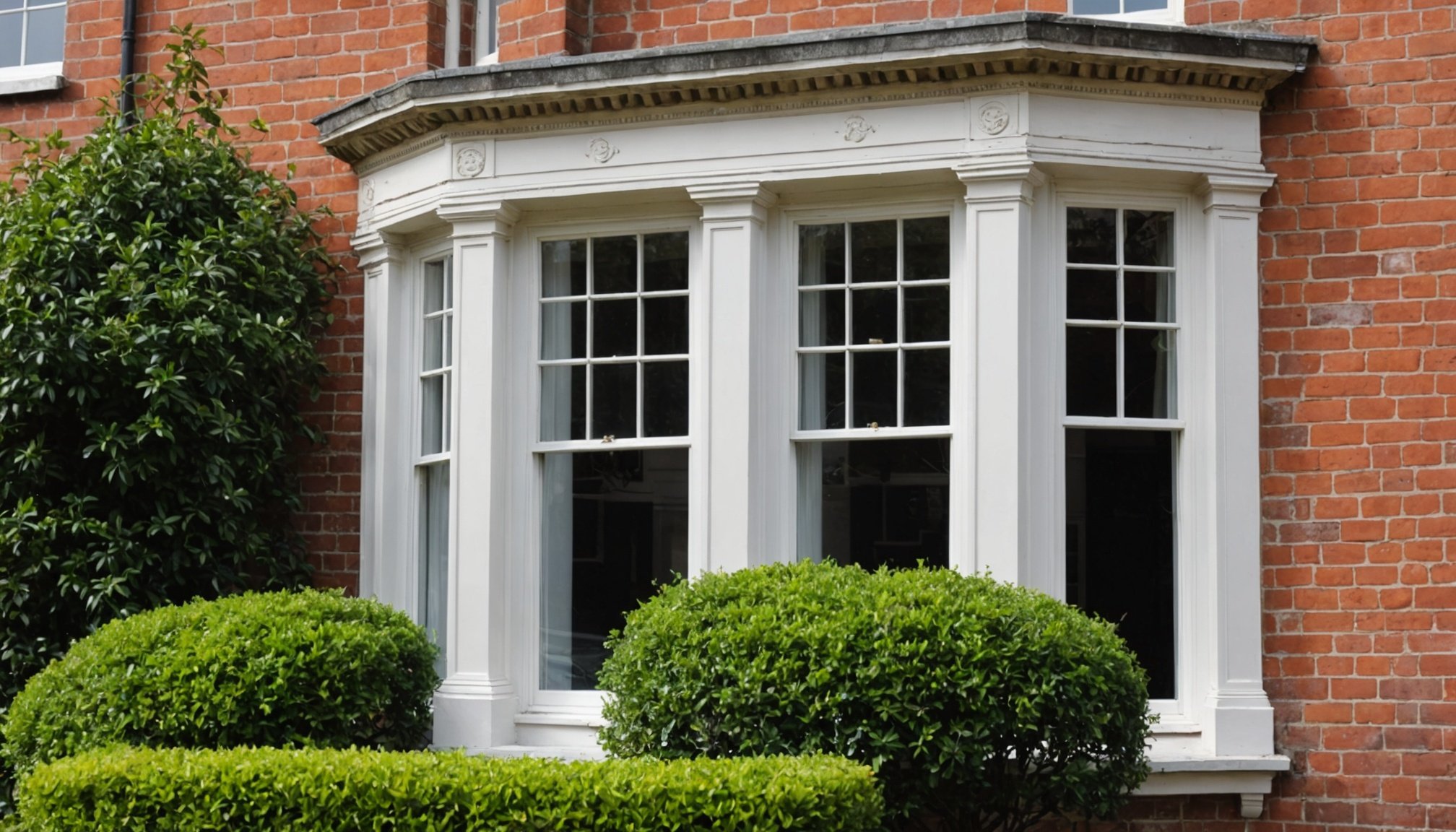Understanding Sash Windows in Period Homes
The charm of sash windows is central to the allure of period homes. These iconic features are indicative of historical architecture, often consisting of vertically sliding panels typically divided into panes by narrow wooden bars known as glazing bars.
Authenticity in these historical settings is crucial, particularly when considering home renovations. Maintaining original features like sash windows honors the architectural heritage and retains property value. However, restoring these beautiful features can be challenging due to age-related issues common in sash windows across the UK.
In parallel : Illuminating Art Nouveau: The Ultimate Guide to Lighting Architectural Features in Your UK Home
Common Issues
Sash windows often face challenges such as rot, draughts, and misalignment. Over time, wood decay becomes problematic, significantly impacting the window’s structural integrity. Draughts infiltrate homes through gaps in poorly sealed windows, leading to higher energy costs and discomfort. Moreover, misaligned sashes can result in sticky operations and increased noise levels.
Addressing these issues involves a careful evaluation of each window’s condition. It’s essential to weigh the benefits of restoration against replacement, particularly in period homes where maintaining period authenticity is paramount. Understanding the nuances and requirements of these time-honored structures is vital for anyone embarking on a renovation journey.
Also to discover : Explore the charm of customizable cardboard furniture
Benefits of Weatherproofing Sash Windows
Weatherproofing sash windows can significantly enhance a home’s energy efficiency. This crucial step in maintaining period homes ensures reduced heating costs, keeping expenses manageable for homeowners. By sealing gaps and insulating windows, energy consumption decreases, as less heat escapes through unprotected areas. Weatherproofing thereby aids in creating a more sustainable and economical household.
In addition to saving energy, weatherproofing also elevates home comfort. Properly fitted and insulated sash windows mitigate chilly drafts and maintain consistent indoor temperatures, providing an inviting atmosphere throughout the year. Addressing these elements fosters a comfortable living environment, which is especially important during the winter months when heat retention is critical.
Another advantage is condensation reduction. Poorly sealed sash windows often result in condensation buildup, leading to potential water damage and mould growth. By implementing weatherproofing solutions, you prevent excess moisture from accumulating on window surfaces. This safeguarding step not only protects the window structure but also contributes to a healthier indoor climate by reducing mould and mildew risks.
In summary, weatherproofing sash windows enhances energy efficiency, optimises home comfort, and minimises condensation hazards, making it a wise renovation choice for preserving both the historical architecture and practicality of period homes.
Essential Techniques for Weatherproofing
Weatherproofing sash windows in period homes involves several key techniques aimed at preserving historical architecture while enhancing energy efficiency and comfort.
Draught Proofing
Draught proofing is a critical step in tackling energy loss. Weatherproofing techniques such as sealing gaps with compression strips or foam can greatly reduce air infiltration. You will need tools like scissors and adhesive material to cut and attach these strips around the window frame. This method is straightforward and can be executed as a DIY method.
Secondary Glazing
Secondary glazing involves installing an additional pane of glass inside the existing window. This not only boosts energy retention but also improves sound insulation. Necessary tools include a glazing kit comprising acrylic sheets and magnetic tape, both readily available at hardware stores.
Caulking and Sealing
Caulking is another effective method to seal minor gaps and cracks. A trusty caulking gun and high-quality sealant are vital for this task. Apply the sealant along the window’s edges and smooth out with a finger or spatula. This step ensures a tighter fit, preventing cold air from seeping indoors. Consider enlisting professional help for period homes to maintain period authenticity.
Materials and Tools Required
Embarking on a sash window weatherproofing project requires the right materials and tools to ensure effective results. Understanding the specific needs of period homes will guide you in selecting the right weatherproofing materials.
For draught proofing, compression strips or foam are essential. These are readily available at local hardware stores and provide a cost-effective solution to reduce air leakage. A high-quality caulking gun paired with a reliable sealant will be crucial for sealing minor gaps and cracks effectively, preserving the window’s integrity.
When considering secondary glazing, invest in an acrylic sheet glazing kit. This typically includes acrylic sheets, glazing bars, and magnetic tape. All items are accessible online or at specialist hardware suppliers.
Maintenance products like wood preservative ensure the longevity of the sash window structure. These preventative measures protect against common issues such as rot and decay.
For DIY enthusiasts, standard household tools such as scissors, a measuring tape, and applicators will support project execution. With the right combination of materials and tools, enhancing energy efficiency and comfort becomes a manageable endeavor, even while maintaining the architectural beauty of period homes.
Potential Challenges and Solutions
Restoring period sash windows presents unique challenges, but understanding these can streamline renovation processes. Common problems include rot, draughts, and misalignment, which impact energy efficiency and window functionality. Addressing the distinctive issues of period homes demands careful planning and implementation of effective solutions, often requiring precise attention to detail.
Identifying issues involves thorough assessments. For instance, assessing window frames and sashes for signs of rot is crucial. This includes checking for softwood and visible decay, impacting the window’s structural integrity. Period windows can particularly suffer from draughts due to worn-out seals and timber shrinkage, contributing to heat loss.
Solutions include targeted restoration techniques. For rot, replace the affected wood sections with matching period materials. Incorporating draft-proofing strips helps in reducing air infiltration, dramatically increasing comfort. Regular maintenance prevents future damage by keeping frames in optimal condition.
Consulting a professional should be considered for extensive restorations. Experts provide tailored solutions, blending modern efficiency with historical accuracy. This expertise is especially crucial when original craftsmanship elements, like glazing bars, remain integral to maintaining the property’s historical value. Proper intervention can considerably enhance both the window’s lifespan and the home’s comfort without compromising its period charm.
Maintaining the Aesthetic Integrity
Enhancing period aesthetics in sash window renovations involves respecting historical accuracy. To preserve the charm while introducing modern conveniences like weatherproofing, a sensitive approach to restoration techniques is vital.
Choosing the Right Finishes
Select finishes that align with the home’s original period style. Ensure paint colours are historically accurate, using samples from existing woodwork to guide choices. Opt for water-based paints, as they allow wood to breathe, prolonging the window’s longevity.
Period-appropriate Repairs
Repair methods should focus on maintaining the original materials and craftsmanship. Use conservation-grade products for straightforward repairs, like epoxy resins for minor wood damage. For extensive decay, employ like-for-like timber replacements to retain historical accuracy.
Balancing Function and Form
Striking a balance between functionality and historical architecture ensures that weatherproofing measures do not detract from visual appeal. Install secondary glazing discreetly, ensuring it is removable and minimally visible. When upgrading sash cords, select traditional materials that complement existing features, ensuring both functionality and period fidelity.
This thoughtful combination of restoration techniques helps maintain the delicate equilibrium between modern demands and the architectural elegance of period homes.
Resources for Professional Help
Navigating** historical restoration projects, especially with sash windows, often requires expert assistance to ensure authentic results. Understanding when to hire an expert over DIY methods is crucial in preserving **period aesthetics*.
When to Hire an Expert
Professionals should be consulted for extensive restorations involving intricate historical architecture elements. If faced with significant rot, broken glazing bars, or severely misaligned windows, experts offer tailored solutions that blend modern efficiency with original design. Their intervention is invaluable in maintaining the window’s period authenticity.
Finding Qualified Professionals
Locating specialists in period homes requires careful selection. Seek professionals with a proven track record in conservation and restoration. Recommendations from heritage associations or previous clients can provide assurance of competence. Additionally, checking for membership in relevant historical restoration bodies ensures adherence to industry standards.
Relevant Associations and Resources
Several organisations offer resources and support for homeowners of period properties. The Society for the Protection of Ancient Buildings and the National Trust provide valuable guidelines and the ability to connect with knowledgeable professionals. Engaging with these resources enriches understanding and ensures high standards of maintenance and restoration are observed, preserving the architectural legacy of these homes.











